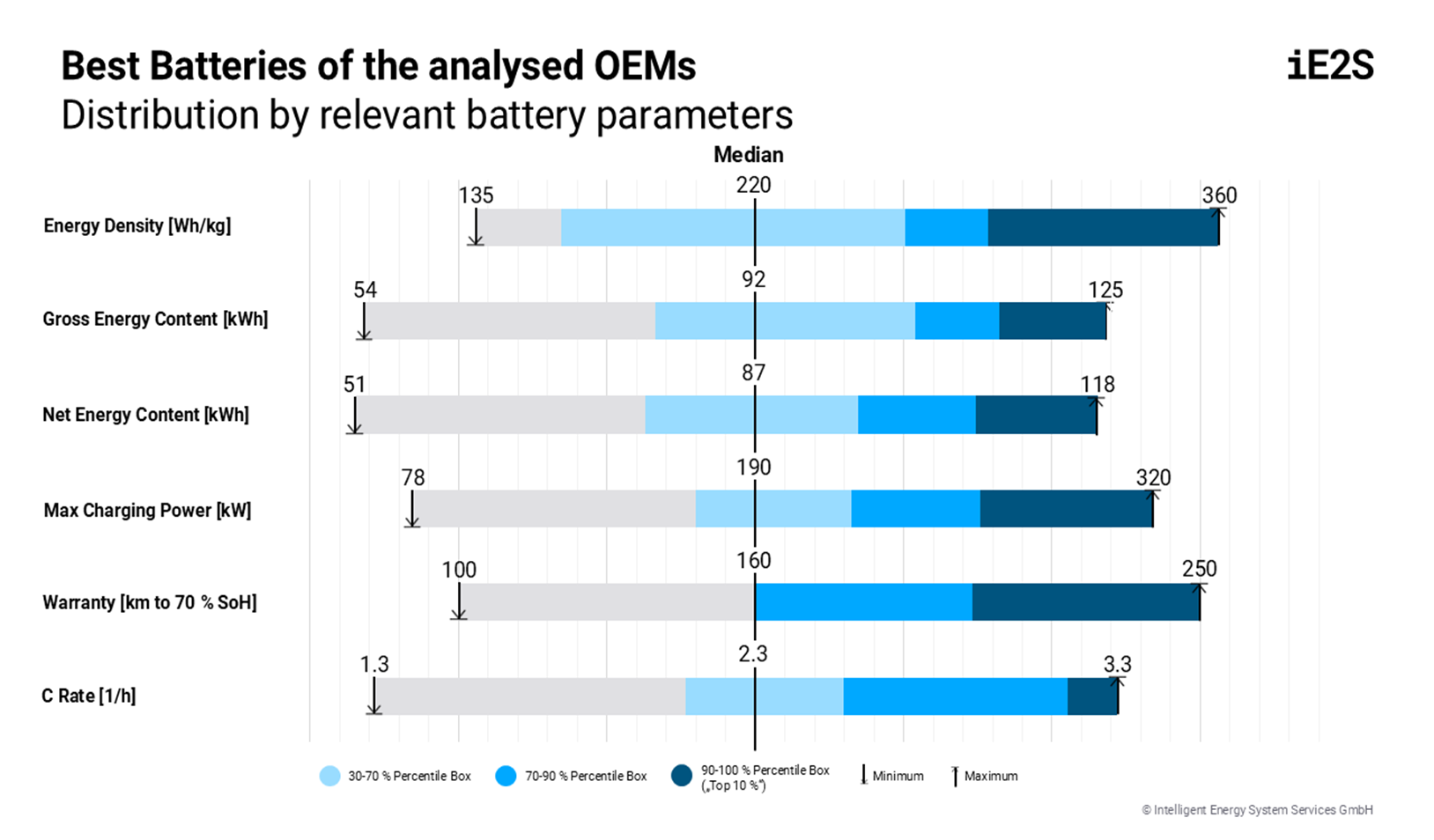E-Mobility Benchmarking – Best Battery
Technological Excellence in E-Mobility
Which manufacturers are setting the benchmark in battery t echnology? Our E-Mobility Benchmarking analysis examines energy density, storage capacity, and charging performance – key factors shaping the future of electric mobility. A closer look at the results reveals significant differences and promising potential.
The battery is the core component of an electric vehicle, significantly influencing key purchasing factors such as range, charging speed, and overall practicality. In our analysis of the "Best Battery" category, we compare the battery technologies of leading automotive manufacturers, focusing on critical performance and efficiency criteria.
For this evaluation, we have analysed each manufacturer’s most advanced battery, defined as the one with the highest energy density.

Compact power for maximum range
Energy density – measured in Wh/kg – indicates how much energy can be stored per kilogram of battery weight. Higher values result in lighter, more efficient vehicles with greater range.
The energy density values vary significantly: The median of the batteries analysed is 220 Wh/kg, with leading manufacturers exceeding this benchmark. These manufacturers gain a technological advantage by increasing range without adding weight, setting new industry standards while continuing to refine their technologies.
Manufacturers with lower energy density face the challenge of improving their battery performance to remain competitive. Achieving this requires not only technological advancements but also strategic decisions in supply chain management and production optimisation.
A measure of storage capacity and range
Energy content – also referred to as storage capacity and measured in kilowatt-hours (kWh) – indicates how much energy a battery can store in total (gross) and how much of it is actually available for use (net). This distinction is relevant, as usable energy directly impacts a vehicle’s range and everyday practicality.
Gross energy content: Among the batteries analysed, the median gross energy content is 92 kWh, with the highest value reaching 125 kWh. These figures represent the total amount of energy a battery can store, including the portion allocated for vehicle peripherals such as cooling systems and onboard electronics. Differences between manufacturers are evident, as the gross value can significantly deviate from the net value in some cases.
Key takeaways
Delta between gross and net energy content: A large gap between gross and net energy content (e.g. 92 kWh gross but only 70 kWh net) suggests that a portion of the battery’s capacity is reserved. This reserve is deliberately designed to protect the battery from excessive stress, preventing deep discharges and premature ageing.
Manufacturers following this approach prioritise long-term reliability, ensuring stable performance over extended periods. While this can slightly reduce the immediately available energy, it enhances battery durability and maintains consistent vehicle efficiency over time.

Time as a key factor
Charging performance, measured in kilowatts (kW), determines how quickly an electric vehicle can be recharged. For many users, this is a crucial factor – especially on long journeys where shorter charging stops significantly enhance convenience.
Significant Variations in Charging Speeds: The charging capabilities of manufacturers vary widely: some reach up to 320 kW, theoretically enabling an 80 % charge of a 100 kWh battery in under 30 minutes. Among the batteries analysed, the median charging power is 190 kW.
At the lower end, some manufacturers offer charging speeds below 100 kW, leading to longer charging times, which are often perceived as a drawback by consumers. These manufacturers may need to upgrade their charging capabilities to meet modern customer expectations.
Key takeaways
While high charging power enables faster recharging, manufacturers must carefully balance charging speed and battery longevity. Optimising this balance is key to maintaining battery health, ensuring long-term performance, and enhancing user satisfaction.
Long-term security for customers
In our analysis, warranty is measured in terms of kilometre coverage, making it a key quality indicator for an electric vehicle’s battery. A longer warranty provides customers with confidence in battery longevity and reflects the manufacturer’s trust in its own technology.
Key findings: Most manufacturers analysed offer a battery warranty of up to 160,000 km. Some extend this further, providing coverage up to 240,000 km under certain conditions.
Additionally, many warranty models also cover the State of Health (SoH), which measures the remaining battery capacity relative to its original storage capacity at the time of purchase. A common condition is that the SoH must not fall below 80 %, provided the guaranteed mileage (e.g. 160,000 km) has not been exceeded. Manufacturers that offer warranties with lower SoH limits or extended mileage coverage reinforce customer trust and position themselves as reliable partners in the market.
- Note: In practise, battery warranties often also include a time-based limitation (e.g. 8 years). However, this aspect is not part of our current analysis, which focuses solely on kilometre-based warranty coverage as a standardised metric.
Key takeaways
Higher mileage warranties increase customer confidence and enhance the appeal of electric vehicles. Manufacturers offering lower warranty coverage risk being perceived as less reliable in the eyes of consumers.
Speed of energy flow
The C-rate, measured in 1/h, indicates how quickly a battery can absorb energy. A C-rate of 1 means the battery can be fully charged within one hour. C-rates above 1/h correspond to charging times of less than an hour and are often linked to fast-charging technology.
Significant variations in charging speed: Charging speeds vary considerably across manufacturers. Our analysis reveals distinct differences in C-rates:
- The median C-rate among the batteries analysed is 2.3/h, meaning a full charge or discharge takes approximately 26 minutes.
- Some manufacturers achieve C-rates of up to 3.3/h, enabling charging times of under 20 minutes.
- The lowest C-rate recorded in our analysis is 1.3/h, corresponding to a charging time of around 46 minutes—which may limit user convenience.
Key takeaways
A high C-rate significantly enhances the usability of electric vehicles by reducing charging times and increasing availability for mobility needs. Manufacturers with top-tier C-rates position themselves as leaders in fast-charging technology.
However, it is important to note that frequent fast charging at high C-rates can accelerate battery degradation, potentially shortening its lifespan. Therefore, optimising charging strategies is crucial for balancing performance, durability, and user satisfaction.
How future-proof is your e-mobility strategy?
Our analysis of leading automotive manufacturers in the European market highlights one key factor: Battery technology is the core of e-mobility and a crucial differentiator. The results provide clear insights into the current landscape and tangible opportunities for the future – ranging from energy content and charging performance to overall range.
Are you ready for the future?
Where does your greatest potential for optimisation lie? Together, we can develop strategies to future-proof your battery portfolio and actively shape the future of e-mobility.
Let's connect!
We invite you to exchange ideas, discuss trends, and explore strategies for the evolving e-mobility landscape.
Your IE2S contact for battery technology: Sezer Solmaz
I am excited to share more about
our E-Mobility Benchmarking!
Feel free to reach out
for further information.

Senior Consultant